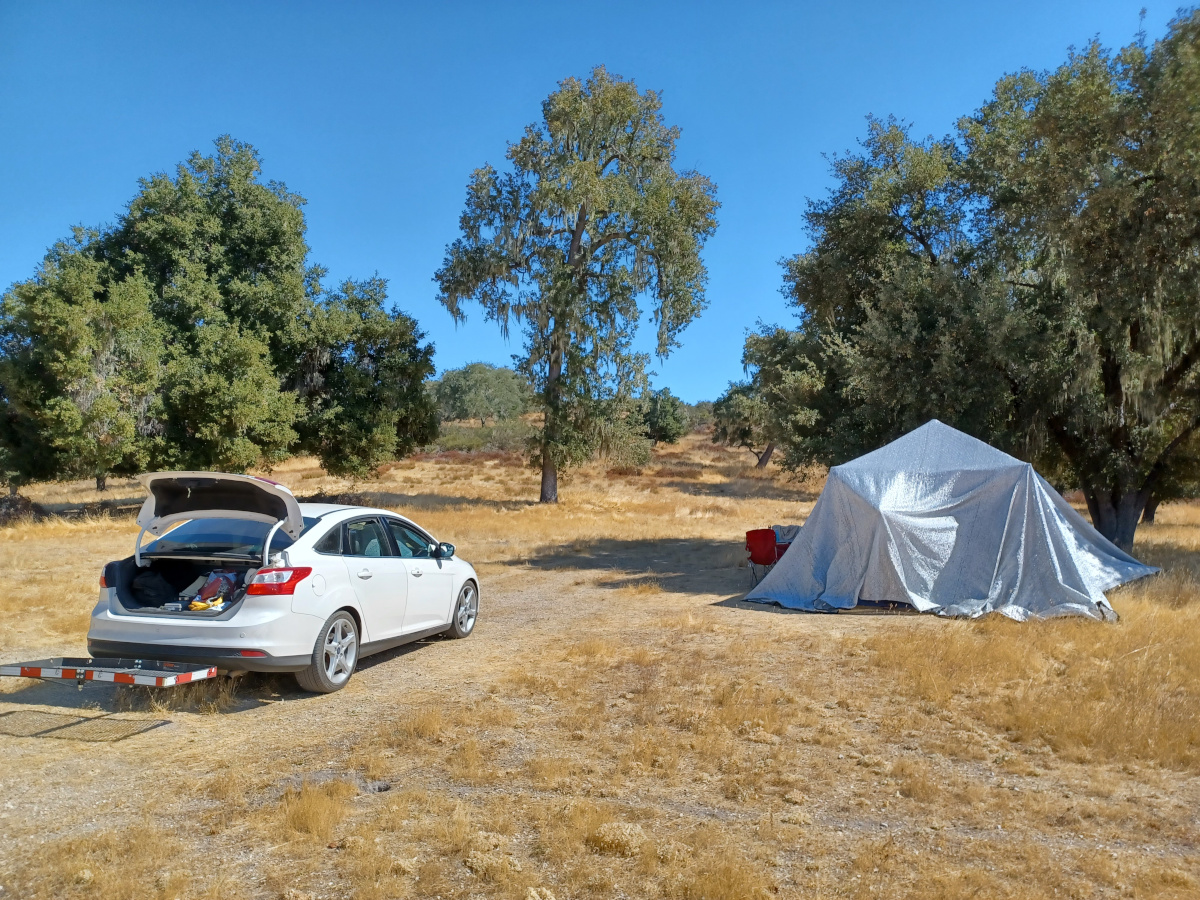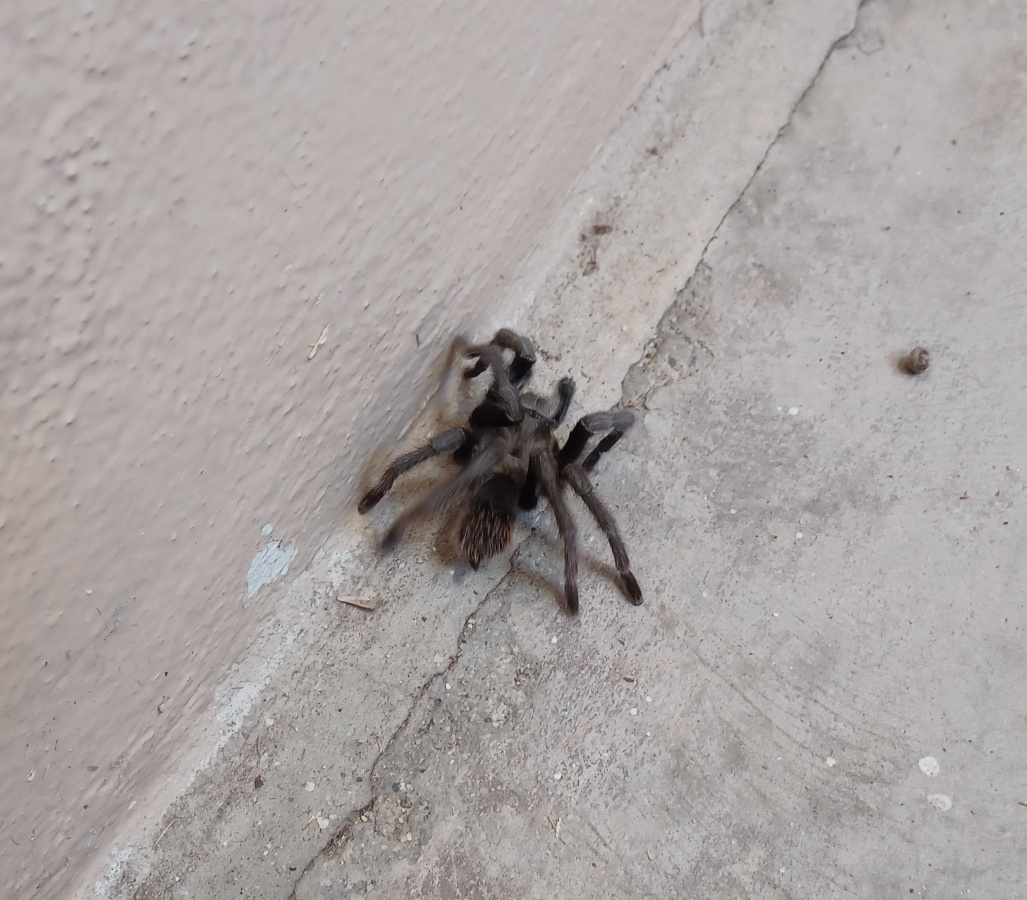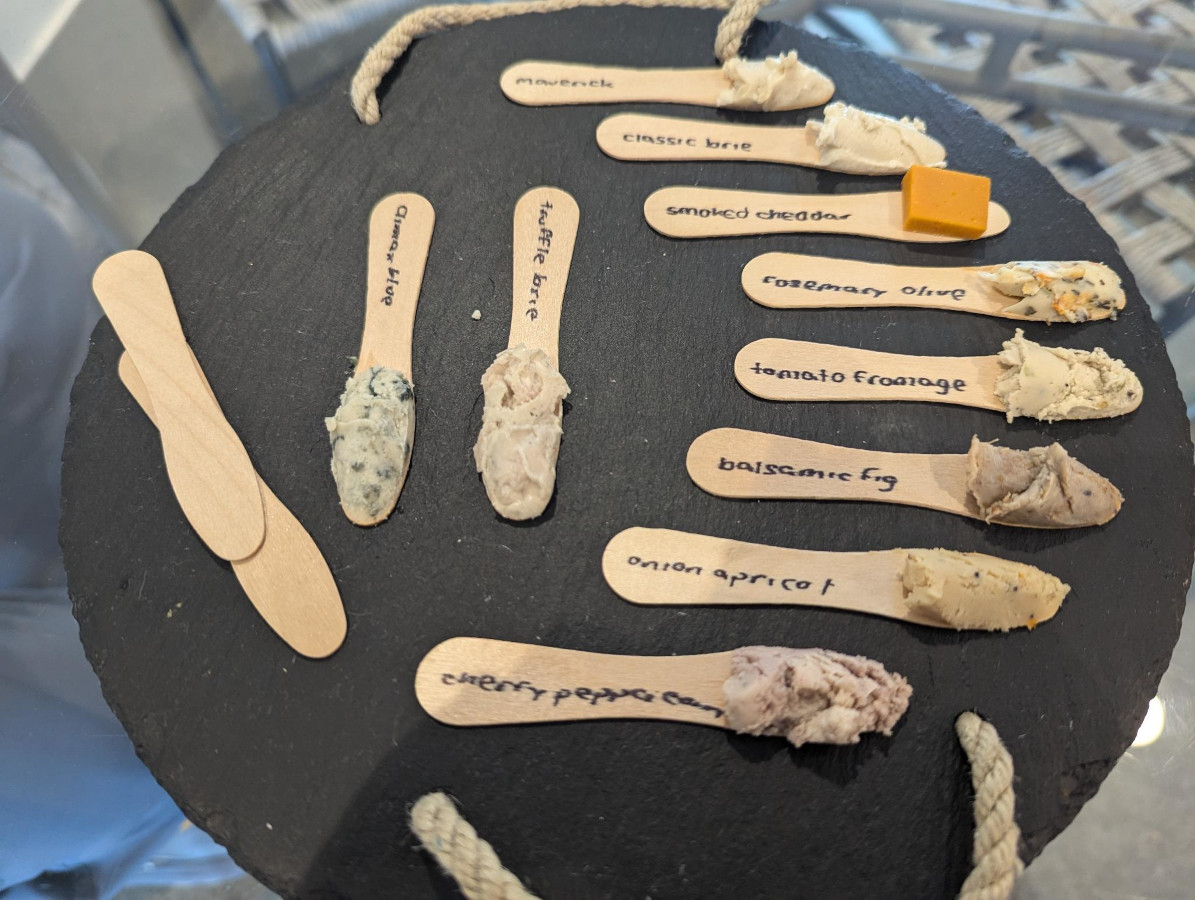



Return to main Astrophotos page
Calstar 2024 was again held at Lake San Antonio, from Oct. 2-6, and we camped for all 4 nights. This year the weather was quite hot, with afternoon temperatures from 100-108° F every day. So in the afternoons we made trips to Lake Nacimiento and Paso Robles to find air conditioning, cold drinks and desserts. On the other hand, the nighttime temperatures were pleasant, and we did not have to wear multiple layers of winter clothes as has often been necessary in other years.
 |
 |
 |
 |
 |
 |
 |
 |
The first night we arrived late and had to set up in the dark. This was the clearest night, but we didn't have the telescope set up until fairly late. The next day we moved the tent to another location with better shade and water access (upper-left image). The last three nights were all affected by clouds to varying degrees, including on the last night when we had to wait several hours for the sky to clear. But we had some amount of clear skies every night. We encountered many animals during our trip, including tarantulas frequently crossing the road in the late afternoon. We even ran into a tarantula trapped in the bathroom at the main campground, which Kathy bravely helped out the door using a long stick. We also saw deer, turkeys, and ground squirrels during the day and heard three kinds of owls at night. There seemed to be some barn owls living in a tree near us that made lots of noise all night. We also sometimes heard (and saw) coyotes, along with other unknown animals walking around in the dark.
The telescope setup was the same as in 2022, with a C14 telescope on a Losmandy G11T mount. The dew shield wasn't needed any of the nights. For photography we continued using an SBIG ST-4K camera (2048 x 2048 pixels, 7.4um) along with an f/7 focal reducer. The camera and mount were controlled using a custom Python GUI interface which is new since last time. For image processing I continued using my old C code for aligning and stacking the images.
 |
| Imax=1.50 |
SBIG ST-4K, 1800s total exposure 10/03/24 Lake San Antonio, CA
This is a close-up of one of the brightest and most intricate portions of the Veil Nebula, a supernova remnant in Cynus. This was taken just after adjusting the telescope collimation, so I was hoping for sharp resolution, though there appears to be some slight stretching of the stars along one axis, likely a tracking issue since I didn't see this in other images.
 |
 |
| Imax=2 | Imax=1 |
SBIG ST-4K, 600s total exposure 10/03/24 Lake San Antonio, CA
I found this barred spiral galaxy in Cetus by accident while looking for NGC 246. A number of fainter galaxies are scattered across the frame as well. (The problem in the upper corners is due to condensation in the camera, with the dessicant needing replacement, but I chose not to crop this image because of some interesting galaxies near the upper edge.)
 |
 |
 |
| Imax=1 | Imax=240 | Nonlinear |
SBIG ST-4K, 1500s total exposure 10/04/24 Lake San Antonio, CA
Known as the "Skull Nebula", NGC 246 is a diffuse planetary nebula in Cetus. The color of the blue central star can be seen in the second image, which is scaled to avoid saturating the color. Although the resolution is not great in this image, the nonlinearly scaled image on the right also shows a white-colored star just next to the blue central star. Clouds were present during this exposure sequence, and at least one of the frames used in the image stacking had reduced transmission and increased background.
 |
 |
| Imax=2.50 | Imax=1.50 |
SBIG ST-4K, 1800s total exposure 10/04/24 Lake San Antonio, CA
This planetary nebula in Cygnus shows a similiar appearance to many others, with a red (probably H-alpha) outer shell surrounding a blue (OIII) interior.
 |
 |
 |
 |
| Imax=100 | Imax=15 | Imax=2 | Nonlinear |
SBIG ST-4K, 300s total exposure 10/04/24 Lake San Antonio, CA
This planetary nebula in Cygnus presents a small but complicated structure with a bright, inner two-lobed structure surrounded by red and blue swirls.
 |
| Imax=0.80 |
SBIG ST-4K, 2100s total exposure 10/04/24 Lake San Antonio, CA
This star field in Perseus includes galaxies PGC 2265215 (magnitude 17.4, 1/3 of the way down from the top border between two stars), PGC 2262555 (magnitude 16, near upper-right corner), and a number of fainter galaxies scattered across the image. These galaxies all appear quite small, but can be distinguished from stars by zooming into the image and looking for objects with a more fuzzy border. Some of the exposures combined into this image were affected by thin clouds.
 |
| Imax=1.20 |
SBIG ST-4K, 1200s total exposure 10/05/24 Lake San Antonio, CA
This was a mostly unsuccessful attempt to capture the Abell 2626 galaxy cluster in Pegasus, after waiting several hours for the clouds to clear. The go-to pointing was slightly off-target, and at the time I could not match the stars in the camera field to the chart. Studying the image later, it turns out that the center of the cluster is beyond the top edge of the image. Nevertheless, some of the faint galaxies near the top of the image belong to the outskirts of the cluster, and many other faint galaxies are scattered across the image.
 |
 |
 |
| digital zoom 2.81 | digital zoom 2.81 | digital zoom 7.01 |
 |
 |
 |
| 15s at 7mm focal length | 15s at 29mm focal length | 8s at 29mm focal length |
 |
 |
 |
 |
 |
| Imax=1600 | Imax=100 | Imax=16 | Imax=6 | Nonlinear |
 |
 |
 |
 |
 |
| Imax=1600 | Imax=100 | Imax=16 | Imax=6 | Nonlinear |
Comet Tsuchinshan-ATLAS became visible in the evening about a week after Calstar. We only observed it from the city, but managed to capture some images. Top row: images taken by Kathy with her phone on the first night we saw the comet from a nearby parking structure. At that time the comet was visible without binoculars despite many bright lights nearby, and we saw it much better with binoculars, but there was only a ~30 minute window after sunset to get a good view before it got too low in the sky. Second row: images taken from our patio six days later, when the comet was in a better viewing position but also noticeably dimmer. Third and fourth rows: close-up images taken through the telescope 3 days later with different exposure settings and scalings used for display. These images show the comet's star-like nucleus, the round coma surrounding it, and the start of the tail. A dark streak can also be seen, perhaps a shadow or part of the dust tail? The background stars appear as streaks because of the comet's motion during the exposure sequences. By this time, the comet was difficult to find in our bright sky even with binoculars.